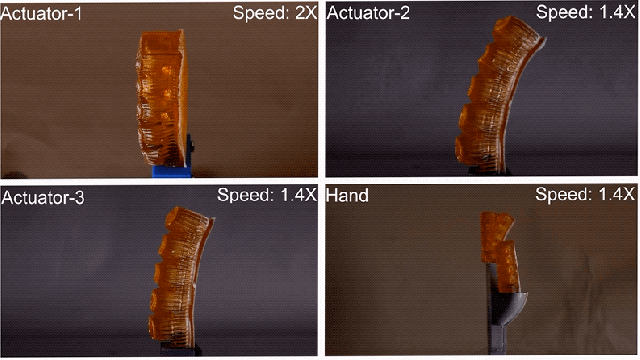An international team of scientists has developed a soft robotic hand that literally perspires in response to excess heat. This innovative concept could improve the durability and endurance of robots, while also allowing them to work in extreme environments.
A soft robotic hand that sweats to keep cool is the subject of new research published today in Science Robotics. Developed by researchers from Cornell University, Facebook Reality Labs, and the Centre for Micro-BioRobotics in Pisa, Italy, the robots maintain a stable “body” temperature by releasing sweat through tiny pores. It’s still early days for this concept, but it could lead to an assortment of robots that can work for prolonged periods without risk of overheating.
Indeed, robots with inadequate forms of thermoregulation could face serious problems in the future, either through the overheating of their internal components or because they’re sent into hot environments, such as in a factory setting. Poor cooling strategies can have a detrimental effect on the durability and integrity of materials and the performance of the robot itself. The authors of the new study devised a solution that took direct inspiration from biology, namely the remarkable cooling powers provided by perspiration.
“It turns out that the ability to perspire is one of the most remarkable features of humans,” explained Thomas Wallin, an engineer and co-author of the new study, at a press conference held yesterday. “We’re not the fastest animals, but early humans found success as persistent hunters. The combination of sweating, relative hairlessness, and an upright bipedal gait enabled us to physically exhaust our prey over prolonged chases.”
In an email to Gizmodo, Wallin said that elite marathon runners, in the right conditions, can lose 3.5 litres (0.93 gallons) of sweat in an hour. That’s “roughly 2.4 kWatts of energy, which is more than many household appliances,” he said. In addition to water having low enthalpy (the amount of energy in a thermodynamic system), evaporation “can lower the temperature of an object below the ambient environment,” said Wallin. Other dissipation processes, namely conduction, convection, and radiation, are “only effective when the environment is cooler than the body,” Wallin told Gizmodo.
These considerations led to the construction of a balloon-like robot deliberately designed to leak water, but only when its temperature exceeds a certain threshold. To make the robot, the researchers 3D-printed fluidic actuators made from hydrogels, specifically a material called poly-N-isopropylacrylamide (PNIPAm). The finger-like actuators held a decent amount of water in its lower layer which, when filled, absorbed heat. The top layer contained micropores that allowed for hydraulic leakage.
PNIPAm reacts to temperature, so sensors or other components were not required. When the temperature was less than 30 degrees Celsius (86 degrees Fahrenheit), the pores stayed closed, but above that, the micropores expanded, allowing the pressurised fluid to trickle out.
“Our design is an example of embodied intelligence,” Wallin told Gizmodo. “Unlike a leaky skeleton, our pores reversibly open and close due to a material response to changing temperatures. Our actuators only sweat when they need to cool.”
In tests, the sweating robots were exposed to wind from a fan, revealing a cooling rate six times better than non-sweating controls. The “measured thermoregulatory performance of these sweating actuators greatly exceeds the evaporative cooling capacity found in the best animal systems,” noted the authors in their study, in reference to both humans and horses. The robotic fingers were also capable of grasping onto and subsequently cooling a variety of heated objects.
“This is fundamental basic research. But, we know that, in the future, robots will have high torque density motors and actuators and… they will be internalized within soft structures that are thermally insulating,” Wallin told Gizmodo. This new solution “will eventually be in robots that can operate for long periods of time without overheating,” he said.
Some limitations were observed, however. When wet, the actuators were slippery, which could make grasping difficult. And because the bots were steadily leaking fluid, they eventually ran out of water. The researchers are currently looking for solutions to these problems, but in the case of a low water supply, future robots could simply “drink” from a refilling station.
Another problem had to do unexpected leaking and a loss of efficiency.
“By creating a microporous actuator for sweating, we did notice a decrease in actuation efficiency,” said Wallin. “The micropores would leak some small amount of sweat even at lower temperatures that hindered actuation. However, this amount was very small when compared to the water loss at higher temperatures when the pores were opened.”
Ultimately, however, this is an elegant proof-of-concept study which shows that bulky, heavy, and costly internal components, such as cooling fans or radiators, aren’t necessarily required to keep robots cool. This solution also lends itself to physical flexibility, which is ideal for soft robots.
These researchers have thus stumbled upon a distinctly lifelike solution to a robotic problem. We tend to think of sweating as a regrettable and often stinky biological necessity, but this research suggests otherwise. Be proud of your sweat! It’s a feat of natural engineering.
Editor’s Note: This article has the US release date. We will update this article as soon as possible with an Australian release date, if available.
